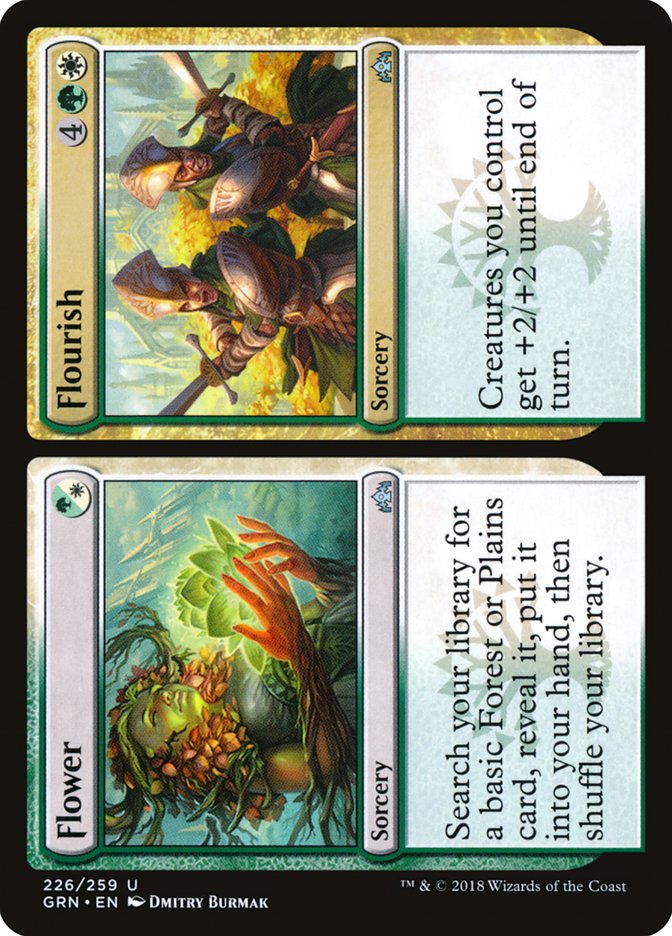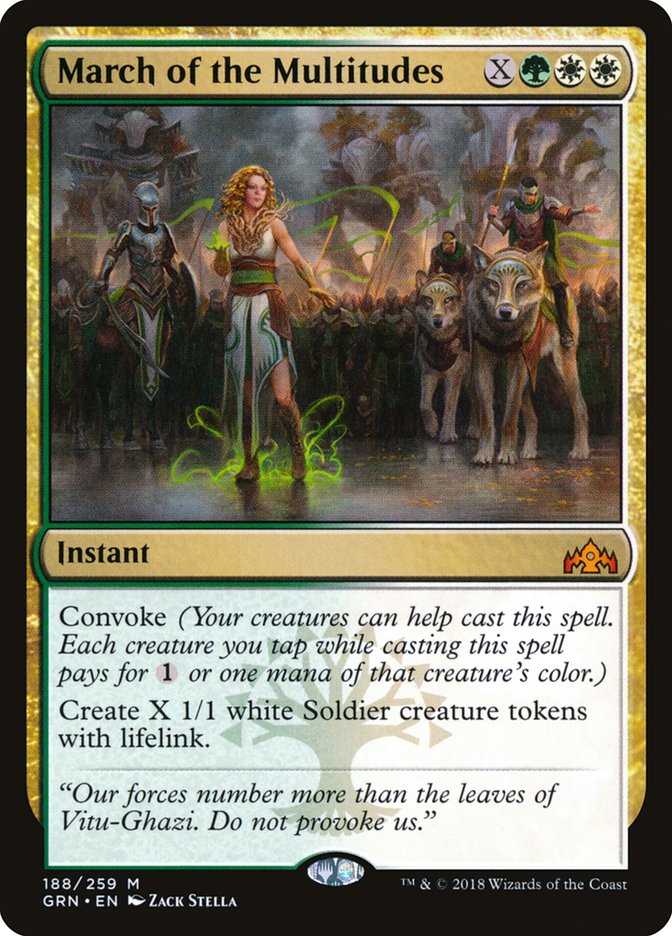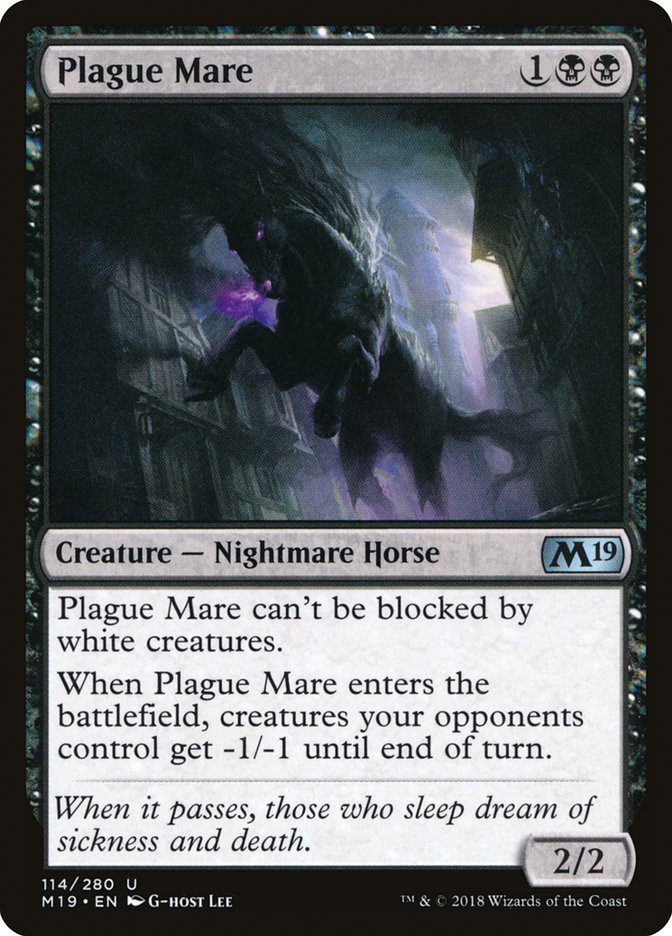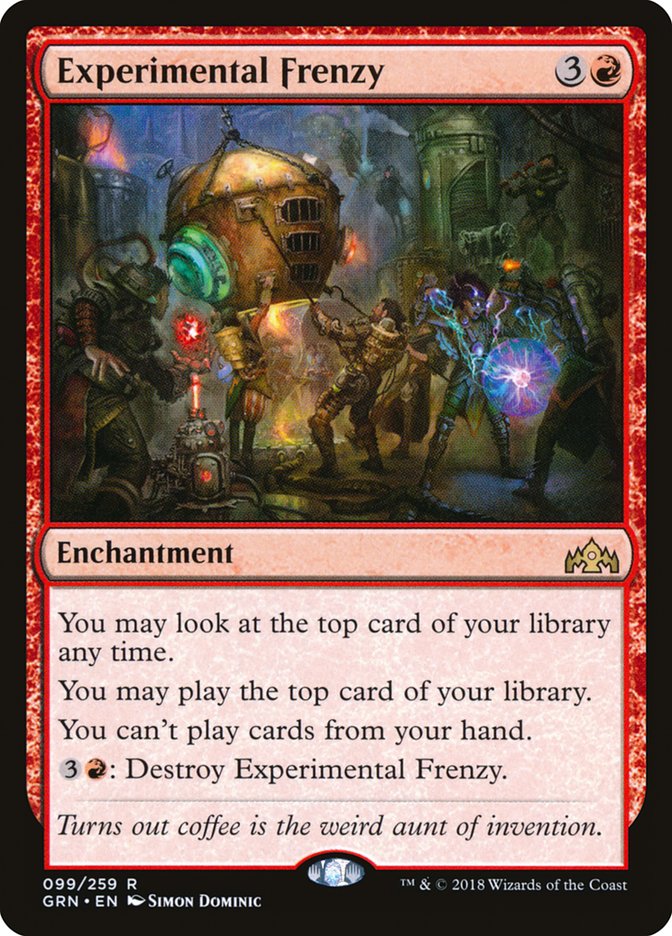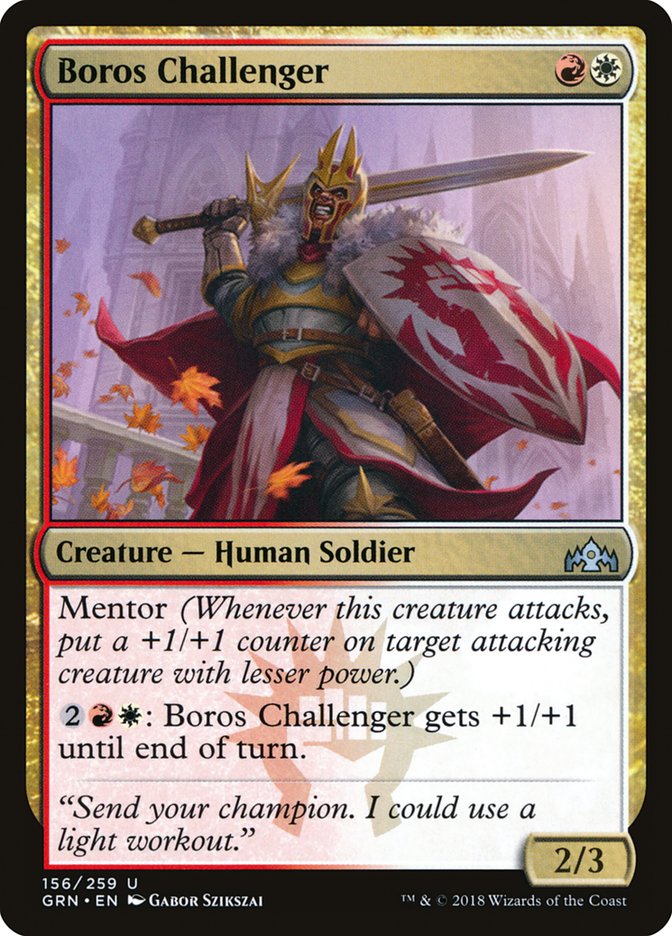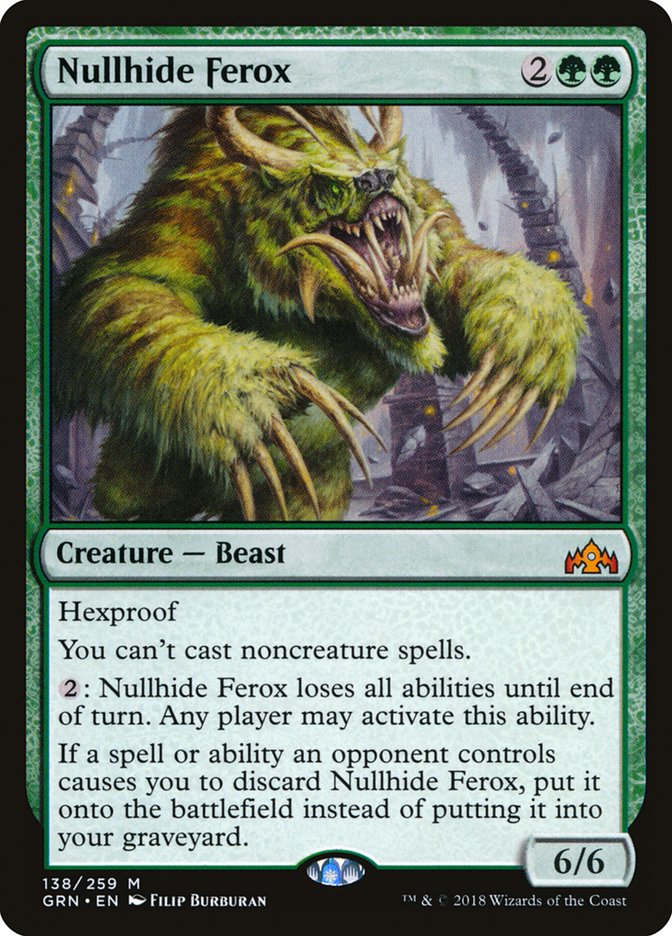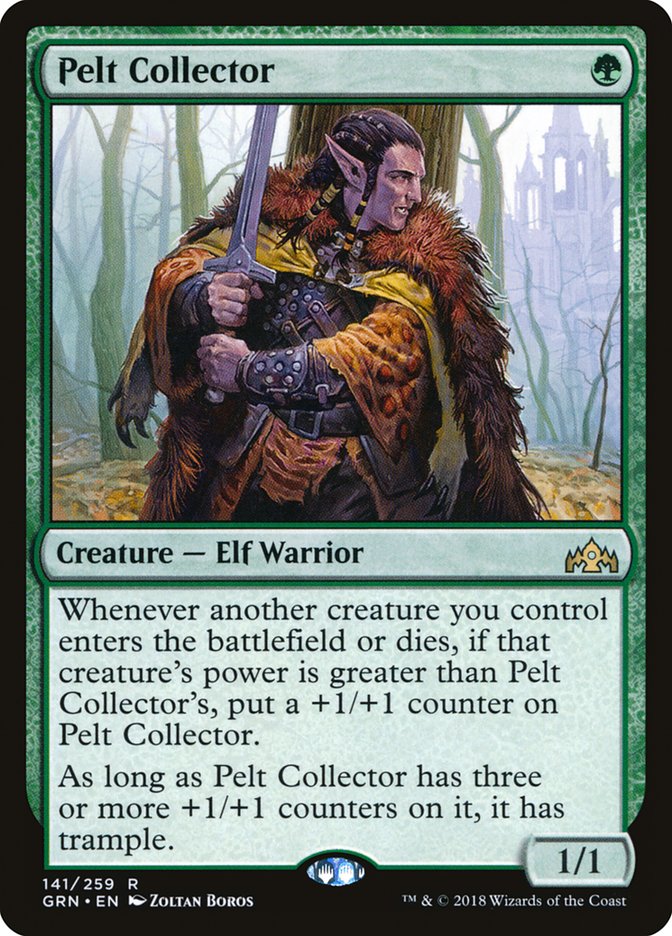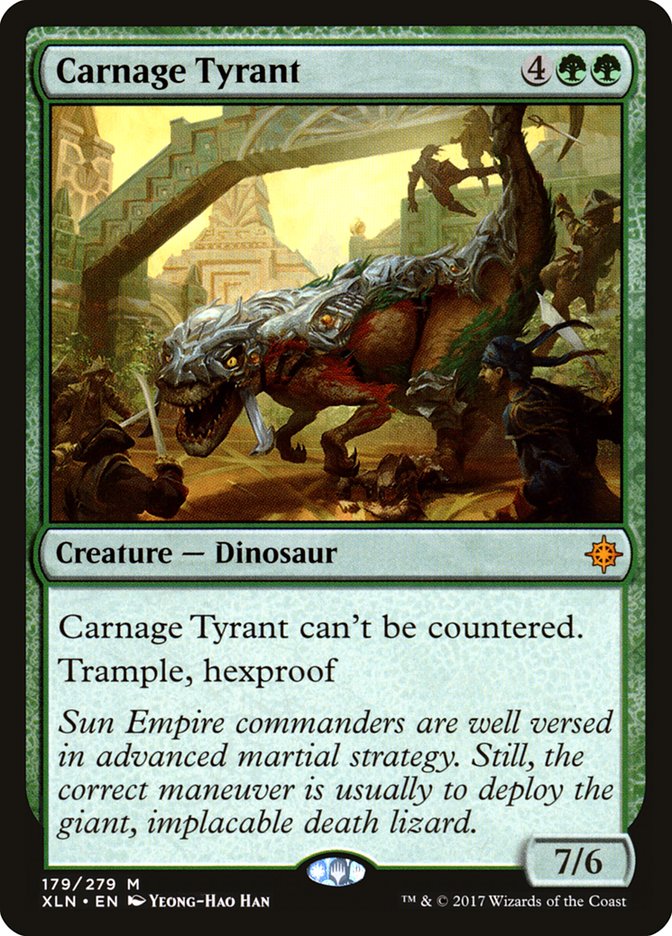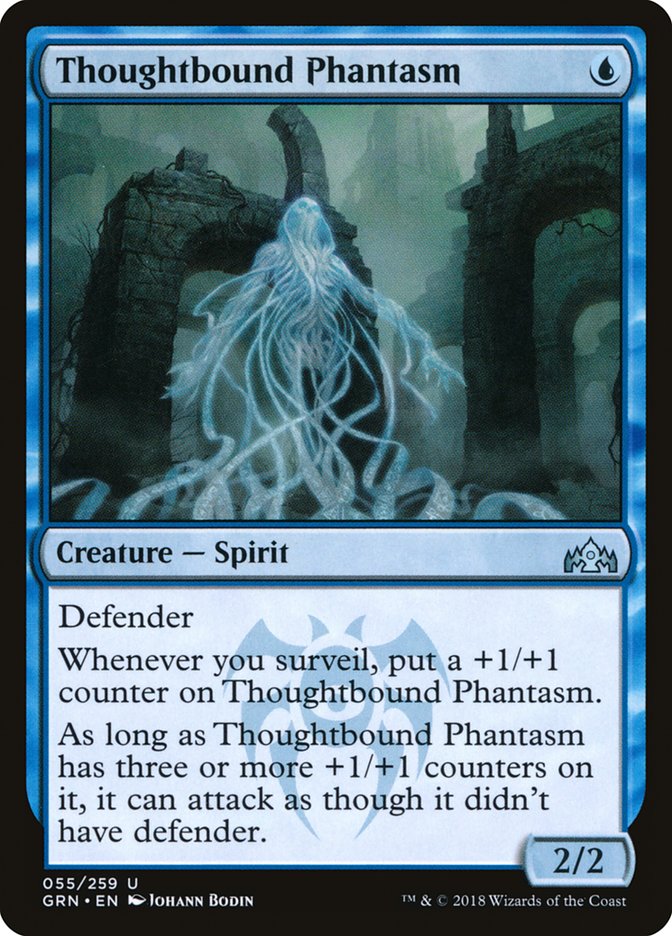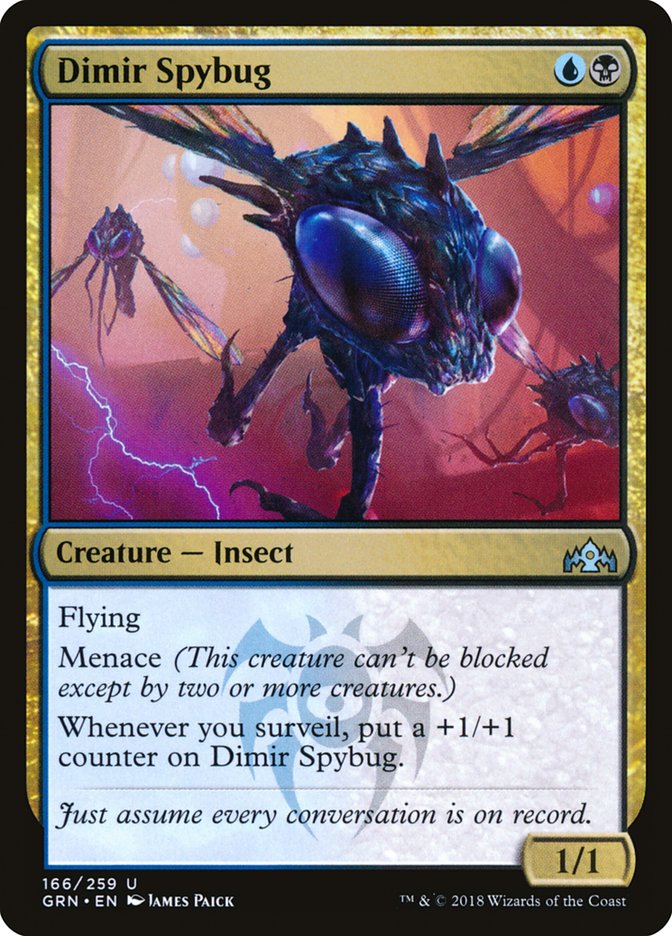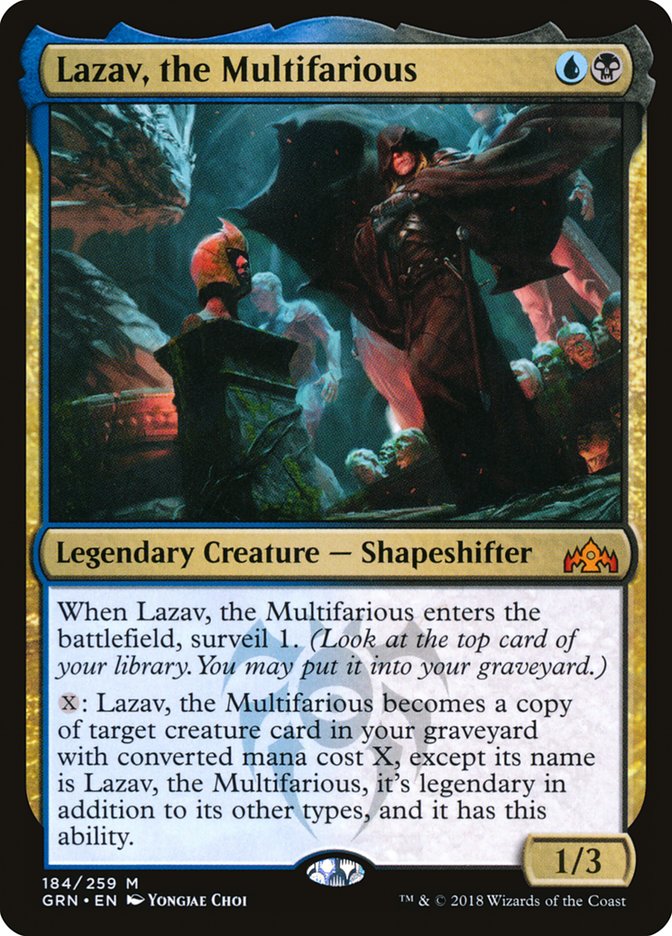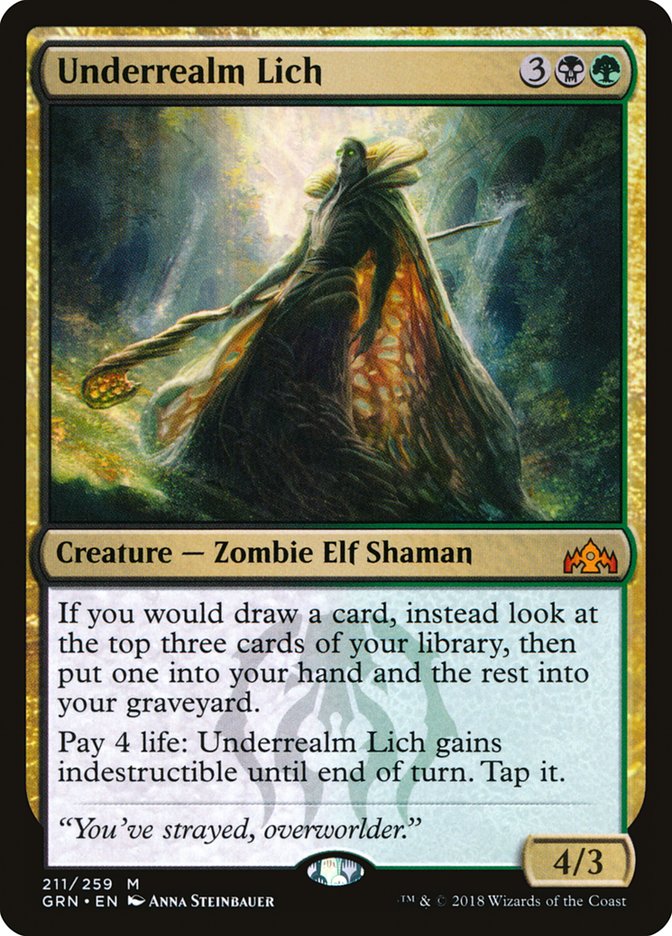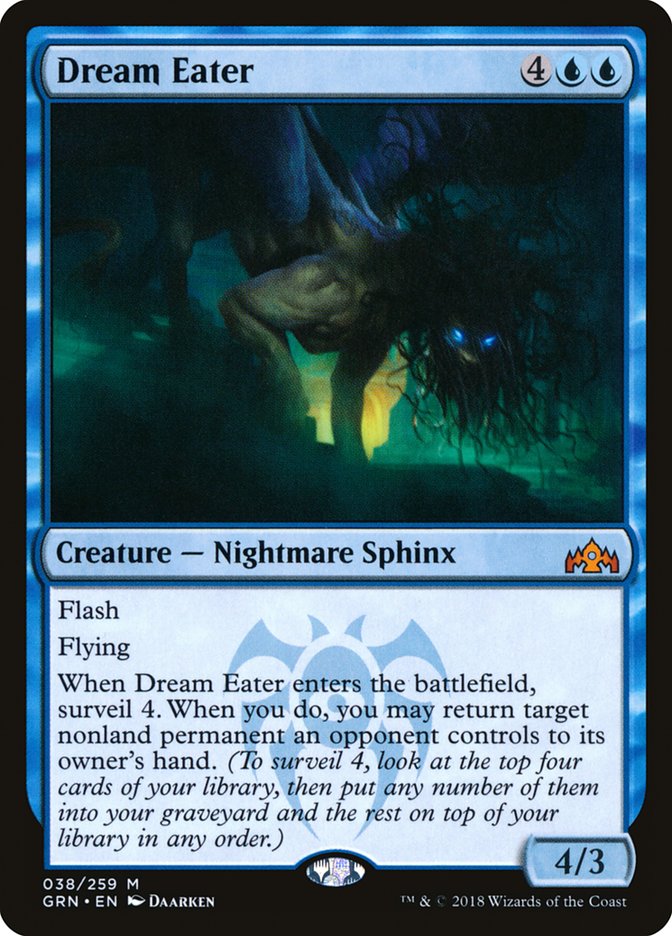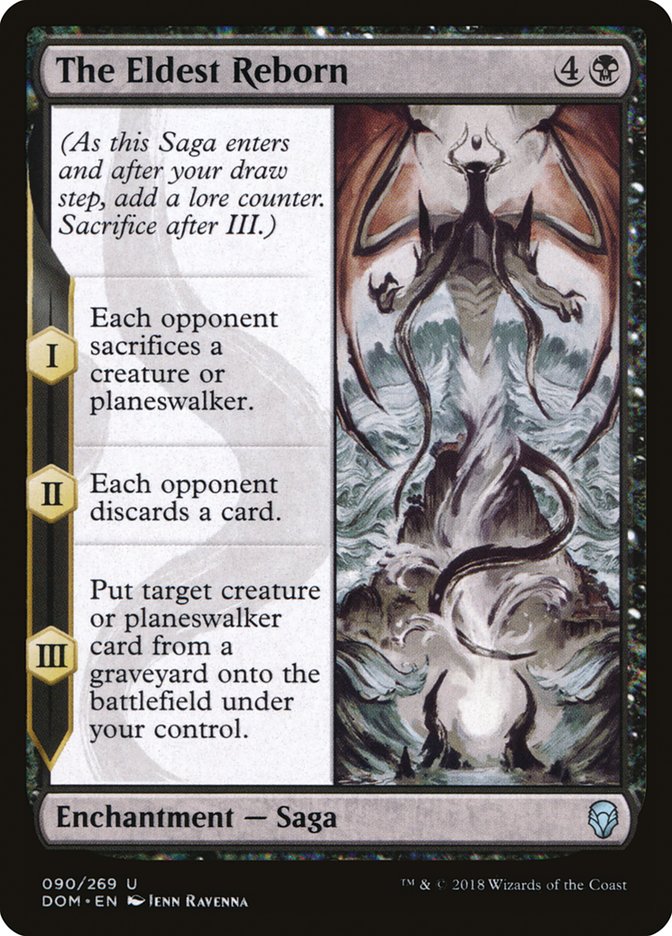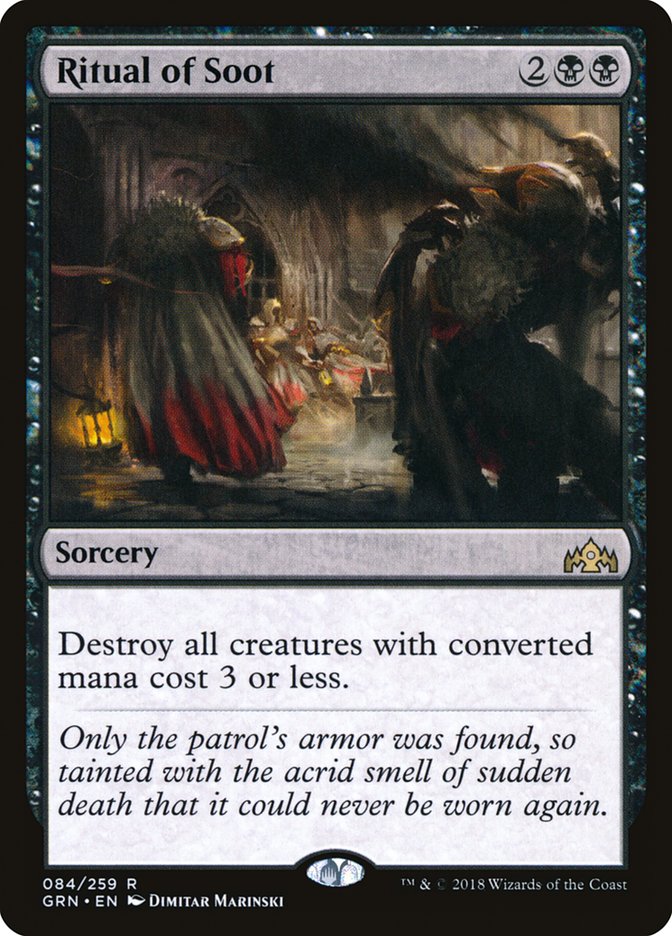It’s time.
The entire Guilds of Ravnica set has been previewed, and it’s time
to build decks to playtest with for SCG Columbus next weekend. So far,
you’ve probably already watched our first test sessions on VS Live! but if
you’re going to be ready for week one in Columbus, you need to build the
decks and playtest for yourself as well. To that end, I’m putting together
the eight decks I’d recommend for you to proxy up and battle your friends
with in my initial Guilds of Ravnica Standard gauntlet.
I have eight decks in the gauntlet to not only represent a Top 8 but also
because it’s a good number of decks that fills most of the styles of decks
in the week one expected metagame. These won’t be the only decks that will
see play, of course, but it should give you a general idea of the format.
When building decks for week one, it’s a general rule that you want to be
proactive since it’s hard to account for everything your opponents could be
playing. Therefore, you’ll notice a general trend towards proactive decks
in the Standard gauntlet I’ve put together as it’s important to know how
they match up with each other. Once we get a better handle on the format
and what the major threats that need answering are, then you usually see an
increase in the midrange and control decks that have answers for those
threats. Yhat doesn’t mean we aren’t going to have any control or midrange
decks in the gauntlet, but they usually require a larger amount of tuning
than the others.
Creatures (12)
Planeswalkers (1)
Lands (22)
Spells (25)

The first deck up in the gauntlet is Selesnya Tokens. This deck is looking
to abuse convoke to go extremely wide around the opponent’s battlefield.
There doesn’t have to be too much removal in this deck as it’s designed to
dominate the battlefield through the overwhelming presence of creatures and
their size.
Flower is a really nice card for this deck as it allows you to play less
lands while still hitting your land drops while later on turning into a
game-winning anthem. It’s the card that makes Selesnya have a better
manabase than the rest of the guilds, which is why it’s Ross Merriam’s pick
for
the strongest guild in the set
.
March of the Multitudes is one of the big payoffs for Selesnya Tokens and
the more I think about the card, the stronger I realize it is. While it may
seem like it’s a bad card against sweepers at first, I don’t believe it is.
It forces the opponent to cast their sweeper on its own while you don’t
need to add more to the battlefield, which is exactly what you want from a
threat. Additionally, since it’s instant speed, if we’re ahead on the
battlefield we can wait until our opponent casts a sweeper and then cast
March of the Multitudes on their end step. If our opponent is hesitant with
their sweeper, we can fully convoke a March of the Multitudes, untap and
play an anthem effect like Pride of Conquerors and win the game
immediately.
I believe people are still underrating the tokens strategies for now, as
they believe Goblin Chainwhirler and Plague Mare will hold them back. While
that may be true to some extent, it won’t be nearly as much as we saw last
Standard season. Goblin Chainwhirler will likely be a card in the Standard
format, but it won’t be nearly to the percentage that we saw this past
summer. With Guilds of Ravnica being a very deep set with plenty
of good cards that rewards players from playing two colors, and with most
of the previous Mono-Red Aggro deck rotating out of the format, it will be
hard to put together a very strong Mono-Red deck moving forward. That
doesn’t mean there won’t be one, but it will be a much smaller part of the
overall metagame than Mono-Red was this summer.
Creatures (27)
- 4 Rigging Runner
- 4 Fanatical Firebrand
- 4 Goblin Chainwhirler
- 3 Lightning Mare
- 4 Legion Warboss
- 4 Runaway Steam-Kin
- 4 Goblin Banneret
Lands (22)
- 22 Mountain
Spells (11)

That doesn’t mean that Mono-Red Aggro shouldn’t be a part of our Standard
gauntlet, so let’s go there next. This is the deck that you’ll be able to
see me play on VS Live! today at 1:00pm ET and I’m really excited to try it
out. The goal here is to stay very low to the ground with twelve one-drops
in order to fully maximize one of the most impressive cards from Guilds of Ravnica so far:
When I wrote about Experimental Frenzy
last week while analyzing the Boros cards
from Guilds of Ravnica, I was very excited to try the card out.
Now after seeing it in action twice on VS Live! I can safely say this card
is really, really good. It has the ability to give red aggressive decks
incredible card advantage like they haven’t seen before. So far we’ve only
tried Experimental Frenzy in the sideboard of red aggressive decks, but
it’s good enough to be built around on its own.
There’s one other red aggressive deck in the Standard gauntlet, so let’s
move on to that deck I wrote about last week:
Creatures (26)
- 4 Boros Challenger
- 4 Legion Warboss
- 4 Goblin Banneret
- 4 Aurelia, Exemplar of Justice
- 3 Hunted Witness
- 4 Swiftblade Vindicator
- 3 Tajic, Legion's Edge
Planeswalkers (2)
Lands (24)
Spells (8)

I’m keeping the same 75 for now that I played on VS Live! last week as I
was very happy about it in the couple games we played. It’s a good testing
deck that will give you looks at plenty of the new cards, but if some of
them don’t hold up to your liking, they can be changed. Mentor incentivizes
you to play a low curve because you want to have another creature on the
battlefield that can attack the same turn you attack with your creature
with mentor. To that end, I advise people to slow down when wanting to
raise the curve with cards like History of Benalia or Rekindling Phoenix to
the maindeck, because even though they’re individually powerful card, they
may reduce the synergy throughout the entire deck.
Most questions about the deck were about either adding History of Benalia
to the maindeck, which is natural because it’s such a strong card, or about
Boros Challenger in the two-drop slot. I think Boros Challenger is quietly
a strong two-drop for the deck, as I value both mentor and the pump ability
highly. The deck only has it and Goblin Banneret as mana sinks for the
lategame, so replacing it with a card that doesn’t have the ability to use
excess mana could make the deck worse later in the game.
Planeswalkers (4)
Lands (27)
Spells (29)

Let’s take a little break from the aggressive decks and go to the entire
other end of the spectrum for a little bit. Even though Guilds of
Ravnica doesn’t have Azorius as one of the focused guilds, Teferi, Hero of
Dominaria is still an incredibly good card that will find its way into the
metagame. Therefore, starting out with an Azorius Control deck in our
Standard gauntlet is going to be necessary.
Is having Teferi, Hero of Dominaria as our only win condition going to be
good enough post-rotation? I’m honestly not sure, but if it is, then Gerry
Thompson’s deck looks to be the best place to start. I’m really worried
about this manabase and imagine there will be plenty of turn 3 or 4
activations of Field of Ruin. This is another deck that you’ll be able to
watch me test on VS Live! today at 1:00pm ET against Todd Anderson.
Creatures (33)
- 4 Llanowar Elves
- 3 Ghalta, Primal Hunger
- 4 Steel Leaf Champion
- 2 Vine Mare
- 4 Thorn Lieutenant
- 4 District Guide
- 4 Nullhide Ferox
- 4 Kraul Harpooner
- 4 Pelt Collector
Lands (24)
Spells (3)
Sideboard

The last of the three decks I’ll be testing on VS Live! against Todd
Anderson, Ben Friedman’s Mono-Green Aggro deck, is Ben’s pick for
The Best Week One Deck For Standard
. Llanowar Elves and Steel Leaf Champion put Mono-Green on the map after Dominaria, and the deck has only been getting more and more tools.
Thorn Lieutenant and Vine Mare joined the ranks in Core Set 2019,
making it the breakout week one deck at the time in the hands of Andrew
Jessup. Now Guilds of Ravnica provides even more strong tools to
the deck.
Nullhide Ferox is one of the top five cards for Standard from Guilds of Ravnica in my opinion, and it isn’t being talked about
enough. Vine Mare was incredibly impactful right away last Standard season,
and Nullhide Ferox is an overall upgrade. I liked the way Ben Friedman
described Nullhide Ferox in his article about the deck:
Cards like Nullhide Ferox make opponents grumble. Cards like Nullhide
Ferox win games by themselves. Cards like Nullhide Ferox turn adequate
decks into great decks.
Pelt Collector gives the deck something it was missing, another good
one-drop besides Llanowar Elves. Greenbelt Rampager was the option that was
played before but is rotating out, and even it felt more like a three-drop
then a one-drop, making it less than ideal. Pelt Collector, on the other
hand, can come down on turn 1 and start growing with each creature that
enters the battlefield or dies. The latter clause is important because it
makes drawing a Pelt Collector late in the game not as bad.
My biggest problem with this decklist as of now is the lack of Carnage
Tyrants in the 75. Between opposing copies of Assassin’s Trophy and Settle
the Wreckage and our own copies of District Guide, I have to believe
Carnage Tyrant deserves to slot in somewhere. This will be one of the
things I keep my eye on when testing the deck on VS Live!
Mono-Green Aggro will almost certainly be one of the most played week one
decks, so you’ll need to be prepared for it. It features a shell that’s
mostly intact from last Standard season, making it easier to build for most
players and is straightforward to play. Oh yeah, it’s also really good.
The last three decks are all going to include the colors blue and black,
but are vastly different decks.
Creatures (19)
- 4 Nightveil Sprite
- 3 Doom Whisperer
- 4 Thoughtbound Phantasm
- 2 Lazav, the Multifarious
- 2 Blood Operative
- 4 Dimir Spybug
Lands (22)
Spells (19)
Sideboard

One of the most impressive decks I’ve seen on VS Live! so far, relative to
how good I thought it was going into watching it, is Todd Anderson’s Turbo
Surveil deck. This is an aggressively-slanted midrange deck that has a good
combination of cheap threats, card draw, and a heavy hitter on the top end.
While it’s likely this deck will need some more tuning to be on the same
level as other decks in the gauntlet, the synergies within are real, and
it’s worth exploring.
The threats in this deck are all so cheap yet powerful. Usually the threats
you have in Dimir decks either cost a ton of mana or are underpowered, but
Thoughtbound Phantasm and Dimir Spybug are not only cheap but also grow
really big. Nightveil Sprite is the perfect enabler as well that allows you
to continually grow your team and filter through your deck.
This is a wonderful shell for Lazav, the Multifarious, due to the amount of
cheap creatures and surveil to put them into your graveyard. One of my
favorite things I saw Todd Anderson do while playing this deck was to cast
Lazav, with the surveil trigger on the stack, spend one mana to turn it
into Thoughtbound Phantasm to gain a +1/+1 counter, and the following turn
spend two mana to make it Nightveil Sprite, which allowed him to surveil
and add counters to his other two creatures. Having cheap creatures to copy
back and forth is exactly what will make Lazav shine.
I’ve seen plenty of Guilds of Ravnica Standard Golgari-based
decklists so far, and I’m not sure I’ve found one I truly like. There are
so many different cards and directions to go with your Golgari-based
decklist that they need a lot of work tuning against the other decks. With
that being said, I still believe there should be one in the Standard
Gauntlet, and to that end I would start with Brad Nelson’s Sultai Midrange
decklist.
The entire set wasn’t previewed when Brad built this deck originally, so
there are likely going to be some cards that need to change. The most
likely change will be replacing Underrealm Lich with Doom Whisperer. I was
originally pretty high on Underrealm Lich, even
writing an entire article about the card earlier in preview season
, but Doom Whisperer looks to simply be on another level.
Besides that, the rest of the deck looks like a strong option as our
midrange value deck that grinds opponents out. Though I’m playing against
Todd Anderson on today’s edition of VS Live!, I’ll be surprised if he
doesn’t have an updated Sultai Midrange or Golgari Midrange decklist to try
out for it. As of writing this I don’t know what that is yet, but keep your
eye out for that as a potential replacement for this decklist. If not I’m
still happy with how this decklist looks for our Standard gauntlet.
Creatures (8)
Lands (26)
Spells (26)
- 3 Essence Scatter
- 4 Vraska's Contempt
- 2 Arguel's Blood Fast
- 3 Moment of Craving
- 4 The Eldest Reborn
- 4 Thought Erasure
- 4 Notion Rain
- 2 Ritual of Soot
Sideboard

Our last deck in our gauntlet is going to be our second control deck,
Grixis Control. Nicol Bolas, the Ravager is one of the most individually
powerful cards in Standard currently, and Gerry Thompson’s Grixis Control
deck is a wonderful place to start. Besides Nicol Bolas, Grixis has a good
manabase and plenty of powerful spells, but unfortunately, it’s really
lacking in the creature department as every other creature that was playing
in Grixis last Standard season rotated out.
To fill this void, Gerry included three copies of Dream Eater, which is
certainly a creature I like quite a bit, but at six mana it’s anything but
cheap. I think there may need to be another impactful creature that’s lower
to the curve in the deck to help out the aggressive matchups, but also not
sure if that card’s available. The Eldest Reborn does its best job to help
out by bringing a creature back from the graveyard after a couple turns,
but it’s pretty expensive and slow.
I haven’t tried this deck out yet and it’s very possible it’s perfectly
fine. It doesn’t have as much early removal as last season, but Ritual of
Soot is a wonderful sweeper to have in the maindeck. It’s been an
impressive card so far in testing, and I would like a third copy in the
sideboard as extra help against the Steel Leaf Champion decks. Ritual of
Soot is also a nice option to play before The Eldest Reborn, hopefully
removing your opponent’s small creatures before you make them sacrifice
their large creature.
Have Fun!
One of my absolute favorite times of the year is when a new set is
previewed, and I’m able to build new decks to play with my friends, seeing
the new interactions unfold. My goal today was to help you build a fun and
diverse gauntlet that will represent what you need to be ready for with Guilds of Ravnica Standard, and I hope you’re able to sleeve these
decks up for yourselves and try them out.
Enough reading! Go play Magic!


